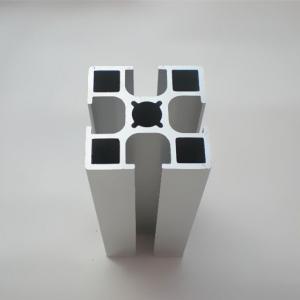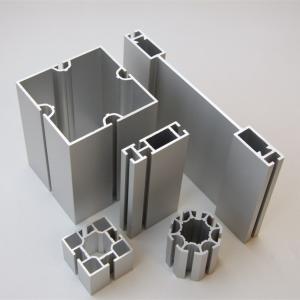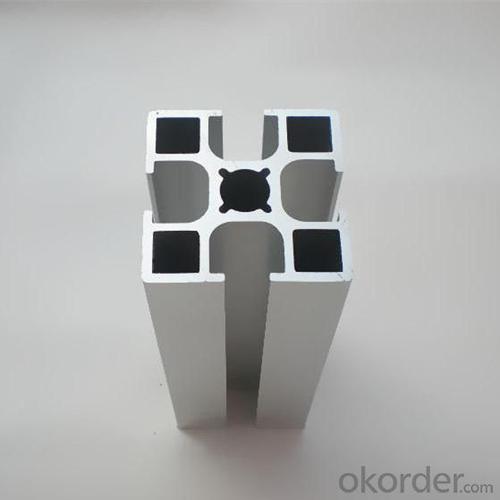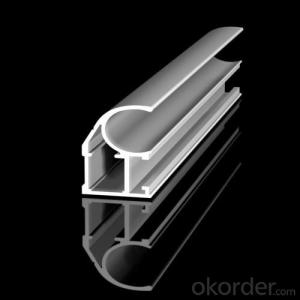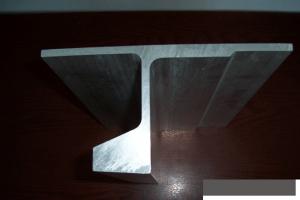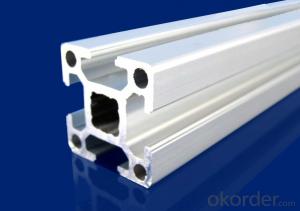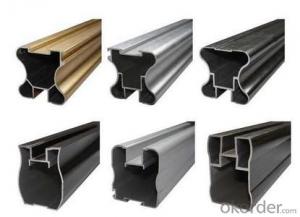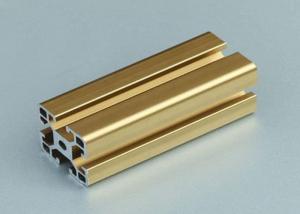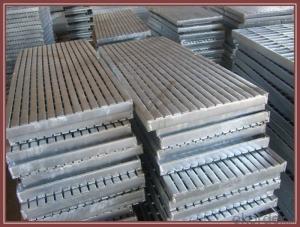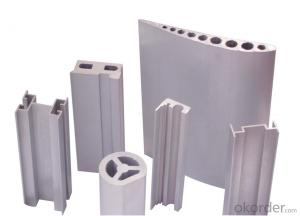Aluminum Profiles 6063-T6
- Loading Port:
- ShenZhen
- Payment Terms:
- TT or LC
- Min Order Qty:
- 5 Tons m.t.
- Supply Capability:
- 1000 Tons Per Month m.t./month
OKorder Service Pledge
OKorder Financial Service
You Might Also Like
1 Specifications of Aluminum Profiles 6063-T6
Alloy Number | 6063 6061 6060 and different aluminium alloy |
Temper | T4 T5 T6 or other special status |
Surface available | Mill finish, Anodized, Powder Coating, Wooden transfering, electrophoresis, heat insulation, PVDF, and deep processing |
Thickness: | >0.8mm |
Width: | <300mm |
Standard | GB5237.1-2008 |
Special Specification is available on customer’s requirement
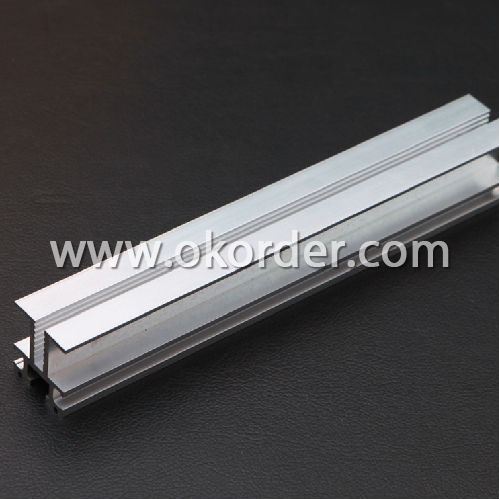
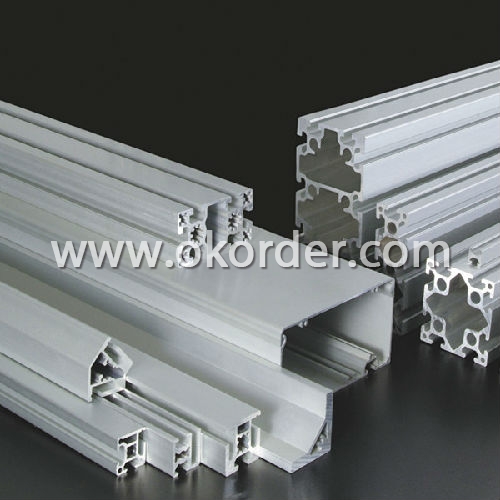
2 Usage/Applications of Aluminum Profiles 6063-T6
Aluminium Profiles are widely used in construction(windows & doors,curtain wall), decoration ( flooring and tiling, kitchen) and industry ( heat sink ).
CNBM produces aluminum profiles which meets the national standard GB5237.1-2008. Our strong quality control term bring you the most-qualified products. And with state-of-the-art equipment, and the state owned company background, we have to say, you will understand why there are so many company choose CNBM to be their supplier.
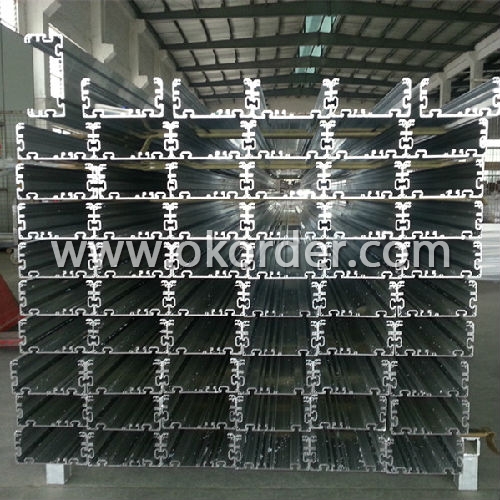
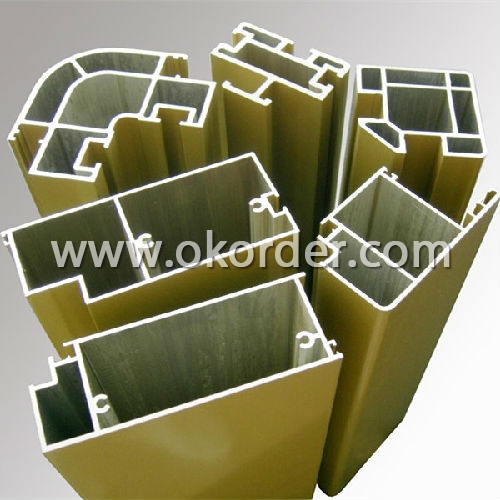
3 Packaging & Delivery of Aluminum Profiles 6063-T6
Packaging: Seaworthy package, bubble plastic bag inside, anti-moisture paper wrapped outside, covered with cartons, on wooden pallets, in containers.
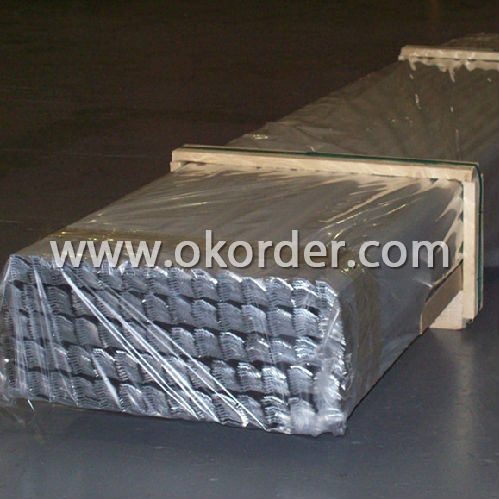
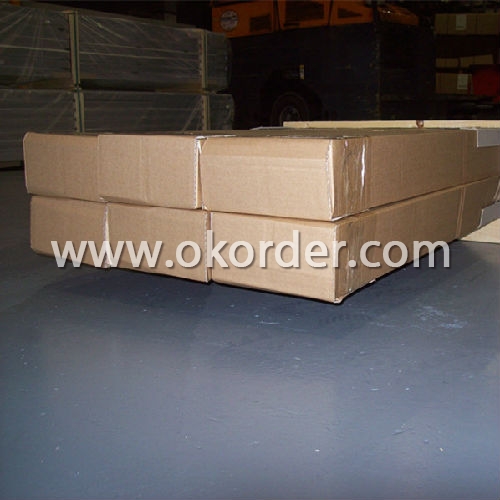
Shipment: the goods will be delivered in 15-30days after getting the buyer's payment.
4 Production Flow of Aluminum Profiles 6063-T6
aluminium ingot & alloy→melting and casting→extrusion→powder coating→pouring rubber for heat insulation→checkout→packing→PVDF coating\anodizing\electrophoresis→put in products warehouse.
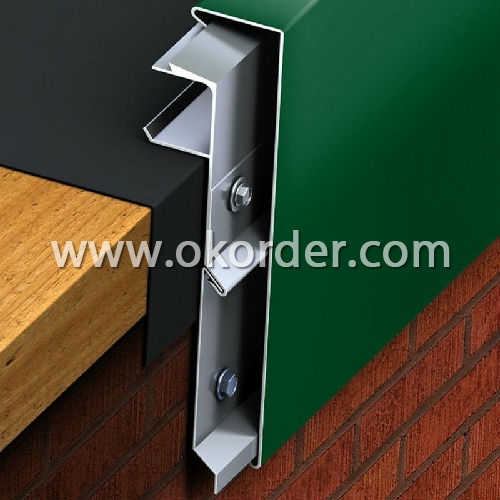
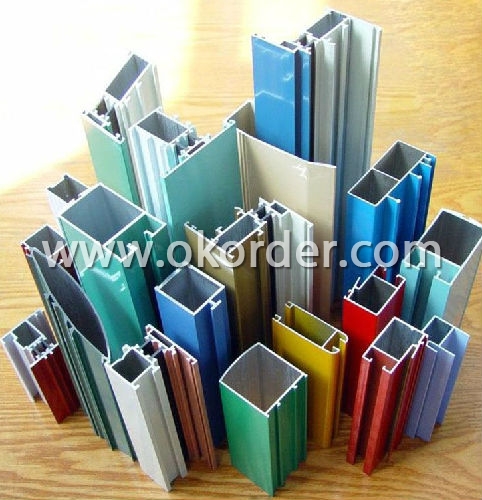
- Q: Are aluminum profiles suitable for use in exterior wall cladding systems?
- <p>Yes, aluminum profiles are commonly used for exterior wall cladding systems. They offer several advantages, including corrosion resistance, low maintenance, and durability. Aluminum profiles are lightweight, which makes them easy to install, and they can be designed to provide thermal insulation. Additionally, they can be powder-coated in various colors, offering aesthetic flexibility. However, it's important to ensure that the profiles meet the necessary standards for weather resistance and structural integrity.</p>
- Q: What are the different bending radius options for aluminum profiles?
- The bending radius options of aluminum profiles differ based on the particular design, thickness, alloy, and temper of the profile. Typically, aluminum profiles can be bent to a radius ranging from 1.5 to 2 times the thickness of the profile. However, this can be influenced by factors such as the strength of the alloy, the shape of the profile's cross-section, and whether it has internal or external radii. Thicker profiles generally require a larger minimum bending radius, whereas thinner profiles can achieve smaller bending radii. It is important to note that attempting to bend a profile below its recommended minimum bending radius can result in deformation, cracking, or even failure. In certain cases, aluminum profiles can undergo cold bending, which involves bending them without the need for heating. Cold bending allows for tighter radii and can be accomplished using specialized bending equipment or processes. Nevertheless, it is crucial to refer to the manufacturer's specifications or seek professional advice to determine the appropriate bending radius options for specific aluminum profiles.
- Q: This question asks about the strength and suitability of aluminum profiles for outdoor applications.
- <p>Yes, aluminum profiles are strong enough for exterior use. They are lightweight, durable, and resistant to corrosion, making them ideal for outdoor applications. Aluminum profiles can withstand various weather conditions and maintain their strength over time. They are also low-maintenance, as they do not rust or rot, and can be easily cleaned. Additionally, aluminum profiles can be anodized or powder-coated for enhanced durability and resistance to UV rays, further ensuring their suitability for exterior use.</p>
- Q: This question asks for guidance on selecting the appropriate aluminum profiles for a construction project.
- <p>Choosing the right aluminum profiles for your building project involves several steps. First, consider the specific requirements of your project, such as load-bearing capacity, aesthetic preferences, and environmental conditions. Consult with engineers or architects to determine the appropriate strength, size, and shape of the profiles. Next, evaluate the quality of the aluminum, ensuring it meets industry standards for durability and resistance to corrosion. Look for profiles with good thermal insulation properties and UV resistance to maintain performance over time. Finally, consider the cost-effectiveness and availability of the profiles, as well as the ease of installation and maintenance. Always opt for reputable suppliers to ensure you receive high-quality products that meet your project's needs.</p>
- Q: How do aluminum profiles contribute to sustainable building practices?
- Aluminum profiles play a crucial role in promoting sustainable building practices for several reasons. Firstly, aluminum is a highly recyclable material, meaning that it can be melted down and reused multiple times without any loss in quality. This recyclability greatly reduces the need for extracting and processing virgin aluminum, which is an energy-intensive and environmentally damaging process. By using aluminum profiles in construction, we can significantly minimize the demand for new aluminum production, thus conserving natural resources and reducing carbon emissions. Moreover, aluminum profiles are lightweight yet strong, making them ideal for creating energy-efficient structures. The lightweight nature of aluminum reduces the load on the building's foundation and structural elements, resulting in lower material requirements and reduced construction costs. Additionally, a lighter structure requires less energy to heat and cool, leading to decreased energy consumption and reduced greenhouse gas emissions over the building's lifespan. Furthermore, aluminum profiles have excellent thermal and acoustic insulation properties. When properly utilized, they can contribute to the overall energy efficiency of a building by minimizing heat loss or gain through windows and doors. This translates into reduced reliance on artificial heating and cooling systems, leading to decreased energy consumption and lower utility bills. Additionally, aluminum profiles are highly durable and require minimal maintenance. Their resistance to corrosion, weathering, and UV rays ensures a long lifespan, reducing the need for frequent replacements and repairs. This not only saves resources but also reduces waste generation and landfill usage. Lastly, aluminum profiles offer great design flexibility and can be easily integrated into various architectural styles and designs. This versatility enables architects and builders to create aesthetically pleasing and functional structures that meet the needs of occupants while still adhering to sustainable building practices. In conclusion, aluminum profiles contribute to sustainable building practices by being recyclable, lightweight, energy-efficient, thermally insulating, durable, low maintenance, and versatile. By incorporating aluminum profiles into construction projects, we can reduce our environmental footprint, conserve natural resources, and promote a more sustainable future.
- Q: How do you prevent galvanic corrosion when combining aluminum profiles with other metals?
- To prevent galvanic corrosion when combining aluminum profiles with other metals, several measures can be taken. One effective method is to use a barrier between the aluminum and the other metal, such as a coating or a non-conductive material. This barrier helps to isolate the two metals and prevents direct contact, reducing the risk of galvanic corrosion. Additionally, selecting metals with similar electrochemical properties can minimize the potential for galvanic corrosion. Proper insulation and regular maintenance, including ensuring the absence of any electrolytes or moisture, can also help prevent galvanic corrosion in these combinations.
- Q: Are aluminum profiles suitable for use in electronics manufacturing?
- Indeed, aluminum profiles prove to be a fitting option for utilization in the field of electronics manufacturing. Aluminum, being a lightweight material, possesses durability and exhibits exceptional thermal conductivity, rendering it an ideal choice for dissipating heat generated by electronic components. Moreover, its high strength-to-weight ratio facilitates the development of robust and lightweight structures, a particularly advantageous characteristic in electronics manufacturing where weight reduction is frequently sought after. Furthermore, aluminum profiles offer versatility in design and customization as they can be easily machined, welded, and shaped into a variety of forms. The corrosion resistance of aluminum further guarantees the longevity and dependability of electronic devices. Consequently, considering the aforementioned properties, aluminum emerges as a suitable material for use in the realm of electronics manufacturing.
- Q: How do aluminum profiles contribute to sustainable packaging solutions?
- Aluminum profiles play a crucial role in promoting sustainable packaging solutions due to their numerous eco-friendly properties. Firstly, aluminum is a highly recyclable material, and its profiles can be easily recycled without losing their inherent qualities. This allows for a closed-loop recycling system, reducing the need for new raw materials and minimizing waste. Additionally, aluminum profiles offer exceptional strength and durability, ensuring that packaging made from these profiles can withstand rigorous handling and transportation. This durability reduces the likelihood of damage or breakage, resulting in less product waste and minimizing the need for additional packaging materials. Moreover, aluminum profiles provide excellent barrier properties, protecting the contents of the packaging from external factors such as moisture, oxygen, light, and temperature variations. This helps to extend the shelf life of the products, reducing food waste and ensuring that goods remain fresh and safe for consumption. Furthermore, aluminum profiles are lightweight, which contributes to energy savings during transportation. The lightweight nature of aluminum packaging allows for reduced fuel consumption and lower carbon emissions, making it an environmentally friendly choice. Lastly, aluminum profiles are resistant to corrosion, ensuring that the packaging remains intact and functional for an extended period. This longevity reduces the need for frequent replacement, saving resources and minimizing the overall environmental impact. In summary, aluminum profiles contribute to sustainable packaging solutions by being recyclable, durable, providing excellent barrier properties, lightweight, and corrosion-resistant. These properties help to minimize waste, reduce energy consumption, extend product shelf life, and lower carbon emissions, making aluminum profiles an ideal choice for eco-conscious packaging solutions.
- Q: What are the different bending machines or tools used for aluminum profiles?
- There are several bending machines and tools that are commonly used for aluminum profiles. These tools are designed to manipulate aluminum profiles into various shapes and angles to meet specific project requirements. 1. Manual Tube Bender: This is a hand-operated bending tool that is commonly used for smaller aluminum profiles. It consists of a lever and a bending shoe that is used to bend the profile manually. 2. Hydraulic Tube Bender: This machine is equipped with hydraulic power to bend larger and thicker aluminum profiles. It offers more precision and control compared to manual benders, making it suitable for industrial applications. 3. CNC Tube Bending Machine: This is a computer-controlled machine that uses a combination of hydraulic power and computer programming to accurately bend aluminum profiles. It can produce complex and precise bends, making it ideal for high-volume production and intricate designs. 4. Roll Bending Machine: This machine is specifically designed for bending aluminum profiles into curved shapes. It consists of three rolls, with the profile passing through the middle roll while the other two rolls apply pressure to bend it into the desired curve. 5. Mandrel Bender: This tool is used for bending aluminum profiles without deforming or collapsing the inner diameter. It uses a mandrel (a rod inserted into the profile) to support the inner wall during the bending process, ensuring a smooth and consistent bend. 6. Rotary Draw Bender: This machine uses a combination of bending dies and a rotating arm to produce accurate and repeatable bends in aluminum profiles. It is commonly used for bending tubes and pipes, but can also be adapted for aluminum profiles. These bending machines and tools offer different levels of precision, control, and production capacity, allowing manufacturers and fabricators to choose the most suitable option based on their specific needs and requirements.
- Q: Can aluminum profiles be used for stage and event structures?
- Yes, aluminum profiles can be used for stage and event structures. Aluminum is a lightweight and durable material that is commonly used in the construction industry for various applications, including stage and event structures. Aluminum profiles are versatile and can be easily shaped, cut, and joined together to create custom structures. They offer excellent strength-to-weight ratio, making them suitable for supporting heavy equipment and ensuring the safety of performers and audience members. Additionally, aluminum profiles can be powder-coated or anodized to provide a decorative finish and protect them from corrosion, enhancing the visual appeal and longevity of the structures. Overall, aluminum profiles are a popular choice for stage and event structures due to their versatility, strength, and aesthetic qualities.
1. Manufacturer Overview
| Location | Guangdong, China |
| Year Established | 1991 |
| Annual Output Value | Above US$50 Million |
| Main Markets | Mid East;Eastern Europe;North America |
| Company Certifications | ISO 9001:2000;ISO 14001:2004;OHSAS 18001 |
2. Manufacturer Certificates
| a) Certification Name | |
| Range | |
| Reference | |
| Validity Period |
3. Manufacturer Capability
| a) Trade Capacity | |
| Nearest Port | Nanhai Port |
| Export Percentage | 30%-50% |
| No.of Employees in Trade Department | 21-50 People |
| Language Spoken: | English;Chinese |
| b) Factory Information | |
| Factory Size: | Above 100,000 square meters |
| No. of Production Lines | Above 10 |
| Contract Manufacturing | OEM Service Offered;Design Service Offered |
| Product Price Range | Average |
Send your message to us
Aluminum Profiles 6063-T6
- Loading Port:
- ShenZhen
- Payment Terms:
- TT or LC
- Min Order Qty:
- 5 Tons m.t.
- Supply Capability:
- 1000 Tons Per Month m.t./month
OKorder Service Pledge
OKorder Financial Service
Similar products
Hot products
Hot Searches
Related keywords
